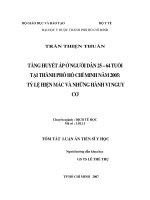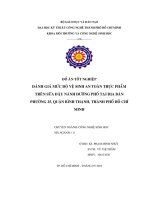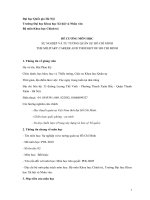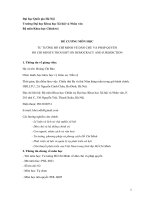- Trang chủ >>
- Đề thi >>
- Đề thi tuyển dụng
Lecture Computer organization and assembly language - Lecture 25: Advanced Procedures - TRƯỜNG CÁN BỘ QUẢN LÝ GIÁO DỤC THÀNH PHỐ HỒ CHÍ MINH
Bạn đang xem bản rút gọn của tài liệu. Xem và tải ngay bản đầy đủ của tài liệu tại đây (170.52 KB, 10 trang )
<span class='text_page_counter'>(1)</span><div class='page_container' data-page=1>
<b>CSC 221</b>
<b>Computer Organization and Assembly </b>
<b>Language</b>
<b>Lecture 25: </b>
</div>
<span class='text_page_counter'>(2)</span><div class='page_container' data-page=2>
<b>Lecture 24: Review</b>
<b>LOCAL flagVals[20]:BYTE ; array of bytes</b>
<b>LOCAL pArray:PTR WORD ; pointer to an array</b>
<b>myProc PROC, ; procedure</b>
<b>LOCAL t1:BYTE, ; local variables</b>
<b>LOCAL Directive</b>
</div>
<span class='text_page_counter'>(3)</span><div class='page_container' data-page=3>
<b>MASM-Generated Code</b>
<b> (1 of 2)</b><b>BubbleSort PROC</b>
<b>LOCAL temp:DWORD, SwapFlag:BYTE</b>
<b>. . .</b>
<b>ret</b>
<b>BubbleSort ENDP</b>
<b>BubbleSort PROC</b>
<b>push ebp</b>
<b>mov ebp,esp</b>
<b>add esp,0FFFFFFF8h ; add -8 to ESP</b>
<b>. . .</b>
<b>mov esp,ebp</b>
<b>pop ebp</b>
<b>ret</b>
<b>BubbleSort ENDP</b>
</div>
<span class='text_page_counter'>(4)</span><div class='page_container' data-page=4>
<b>MASM-Generated Code</b>
<b> (2 of 2)</b>Diagram of the stack frame for the <i>BubbleSort</i>
procedure:
<i>return address</i>
EBP
<sub>EBP</sub>
[EBP - 4]
ESP
temp
</div>
<span class='text_page_counter'>(5)</span><div class='page_container' data-page=5>
<b>INVOKE Directive</b>
• The INVOKE directive is a powerful replacement for
Intel’s CALL instruction that lets you pass multiple
arguments.
• Syntax:
INVOKE <i>procedureName</i> [, <i>argumentList</i>]
• <i>argumentList is an optional comma-delimited list of </i>
procedure arguments.
• <i>Arguments can be:</i>
– <sub>immediate values and integer expressions</sub>
– variable names
</div>
<span class='text_page_counter'>(6)</span><div class='page_container' data-page=6>
<b>ADDR Operator</b>
<b>.data</b>
<b>myWord WORD ?</b>
<b>.code</b>
<b>INVOKE mySub,ADDR myWord</b>
• Returns a near or far pointer to a variable, depending on
which memory model your program uses:
• <i>Small model: returns 16-bit offset</i>
• <i>Large model: returns 32-bit segment/offset</i>
• <i>Flat model: returns 32-bit offset</i>
</div>
<span class='text_page_counter'>(7)</span><div class='page_container' data-page=7>
<b>PROC Directive</b>
• The PROC directive declares a procedure with an
optional list of named parameters.
• Syntax:
<i>label</i> PROC paramList
• <i>paramList is a list of parameters separated by </i>
commas. Each parameter has the following syntax:
<i>paramName </i><b>: </b><i>type</i>
<i>type</i> must either be one of the standard ASM types
</div>
<span class='text_page_counter'>(8)</span><div class='page_container' data-page=8>
<b>AddTwo Procedure</b>
<b> (1 of 2)</b><b>AddTwo PROC,</b>
<b>val1:DWORD, val2:DWORD</b>
<b>mov eax,val1</b>
<b>add eax,val2</b>
<b>ret</b>
<b>AddTwo ENDP</b>
• The AddTwo procedure receives two integers and
</div>
<span class='text_page_counter'>(9)</span><div class='page_container' data-page=9>
<b>PROC Examples</b>
<b> (2 of 3)</b><b>FillArray PROC,</b>
<b>pArray:PTR BYTE, fillVal:BYTE</b>
<b>arraySize:DWORD</b>
<b>mov ecx,arraySize</b>
<b>mov esi,pArray</b>
<b>mov al,fillVal</b>
<b>L1: mov [esi],al</b>
<b>inc esi</b>
<b>loop L1</b>
<b>ret</b>
<b>FillArray ENDP</b>
<i><b>FillArray receives a pointer to an array of bytes, a </b></i>
</div>
<span class='text_page_counter'>(10)</span><div class='page_container' data-page=10>
<b>RET Instruction</b>
• Pops stack into the instruction pointer (EIP or IP).
Control transfers to the target address.
• Syntax:
– <b>RET</b>
– <b><sub>RET</sub></b> <i><b><sub>n</sub></b></i>
</div>
<!--links-->









